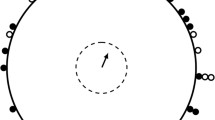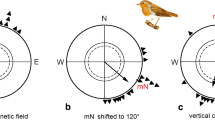Abstract
A proof of magnetic compass learning by pigeons under laboratory conditions has been attempted for decades, but all experiments have failed so far. The aim of the present study was to test whether pigeons can learn magnetic compass directions in an operant chamber if magnetic cues are presented as true spatial cues. Experimental sessions were carried out in the local geomagnetic field and in magnetic fields with matched total intensity and inclination, but different directions generated with Helmholtz-coils. Birds demonstrated successful learning with a performance level comparable to that in learning studies with magnetic anomalies. In addition, we compared the data from magnetic learning in the laboratory with performance from homing experiments in the field. The birds that were more successful in the learning experiment had vanishing bearings farther away from the home direction than the group mean at unfamiliar, but not at familiar sites. This might suggest that better learners explore unknown locations in a different way. Our findings represent the first evidence for operant magnetic compass learning in pigeons and also provide a link between behavioural data from the field and the laboratory.



Similar content being viewed by others
References
Alsop B (1987) A failure to obtain magnetic discrimination in the pigeon. Anim Learn Behav 15:110–114
Batschelet E (1981) Circular statistics in biology. Academic Press, London
Beaugrand JP (1976) An attempt to confirm magnetic sensitivity in the pigeon, Columba livia. J Comp Physiol 110:343–355
Bingman VP, Jones TJ (1994) Sun compass-based spatial learning impaired in homing pigeons with hippocampal lesions. J Neurosci 14:6687–6694
Bookman MA (1977) Sensitivity of the homing pigeon to an earth-strength magnetic field. Nature 267:340–342
Carman GJ, Walker MM, Lee AK (1987) Attempts to demonstrate magnetic discrimination by homing pigeons in flight. Anim Learn Behav 15:124–129
Chappell J, Guilford T (1995) Homing pigeons primarily use the sun compass rather than fixed directional visual cues in an open-field arena food-searching task. Proc Royal Soc B 260:59–63
Clayton NS (1995) Development of memory and the hippocampus: comparison of food-storing and nonstoring birds on a one-trial associative memory task. J Neurosci 15:2796–2807
Couvillon PA, Asam AM, Bitterman ME (1992) Further efforts at training pigeons to discriminate changes in the geomagnetic field. J Exp Biol 173:295–299
Fleissner G, Holtkamp-Rötzler E, Hanzlik M, Winklhofer M, Fleissner G, Petersen N, Wiltschko W (2003) Ultrastructural analysis of a putative magnetoreceptor in the beak of homing pigeons. J Comp Neurol 458:350–360
Fleissner G, Stahl B, Thalau P, Falkenberg G, Fleissner G (2007) A novel concept of Fe-mineral-based magnetoreception: histological and physicochemical data from the upper beak of homing pigeons. Naturwissenschaften 94:631–642
Freire R, Munro UH, Rogers LJ, Wiltschko R, Wiltschko W (2005) Chickens orient using a magnetic compass. Curr Biol 15:620–621
Freire R, Munro U, Rogers LJ, Sagasser S, Wiltschko R, Wiltschko W (2008) Different responses in two strains of chickens (Gallus gallus) in a magnetic orientation test. Anim Cogn 11:547–552
Gagliardo A, Ioalè P, Savini M, Wild J (2006) Having the nerve to home: trigeminal magnetoreceptor versus olfactory mediation of homing in pigeons. J Exp Biol 209:2888–2892
Griffin DR (1982) Commentary ecology of migration: is magnetic orientation a reality? Q Rev Biol 57:293–295
Keeton WT (1973) Release-site bias as a possible guide to the ‘map’ component in pigeons homing. J Comp Physiol 86:1–16
Kramer G (1957) Experiments on bird orientation and their interpretation. Ibis 99:196–227
Kreithen ML, Keeton WT (1974) Attempts to condition homing pigeons to magnetic stimuli. J Comp Physiol 91:355–362
Moore BR, Stanhope KJ, Wilcox D (1987) Pigeons fail to detect low-frequency magnetic fields. Anim Learn Behav 15:115–117
Mora CV, Davison M, Wild JM, Walker MM (2004) Magnetoreception and its trigeminal mediation in the homing pigeon. Nature 432:508–511
Mouritsen H, Ritz T (2005) Magnetoreception and its use in bird navigation. Curr Opin Neurobiol 15:406–414
Prior H, Güntürkün O (2001) Parallel working memory for spatial location and food-related object-cues in foraging pigeons: binocular and lateralized monocular performance. Learn Mem 8:44–51
Rawson KS (1954) Sun compass orientation and endogenous activity rhythm of the starling (Sturnus vulgaris L.). Z Tierpsychol 11:448–452
Ritz T, Adem S, Schulten K (2000) A model for photoreceptor-based magnetoreception in birds. Biophys J 78:707–718
Ritz T, Thalau P, Phillips JB, Wiltschko R, Wiltschko W (2004) Resonance effects indicate a radical-pair mechanism for avian magnetic compass. Nature 429:177–180
Rogers LJ, Munro U, Freire R, Wiltschko R, Wiltschko W (2008) Lateralized response of chicks to magnetic cues. Behav Brain Res 186:66–71
Schmidt-Koenig K (1958) Experimentelle Einflußnahme auf die 24-Stunden-Periodik bei Brieftauben und deren Auswirkungen unter besonderer Berücksichtigung des Heimfindevermögens. Z Tierpsychol 15:302–331
Thalau P, Ritz T, Stapput K, Wiltschko R, Wiltschko W (2005) Magnetic compass orientation of migratory birds in the presence of a 1.315 MHz oscillating field. Naturwissenschaften 92:86–90
Thalau P, Holtkamp-Rötzler E, Fleissner G, Wiltschko W (2007) Homing pigeons (Columba livia f. domestica) can use magnetic cues for locating food. Naturwissenschaften 94:813–819
Vergassola M, Villermaux E, Shraiman BE (2007) ‘Infotaxis’ as a strategy for searching without gradients. Nature 445:406–409
Visalberghi E, Alleva E (1979) Magnetic influences on pigeon homing. Biol Bull 156:246–256
Voss J, Keary N, Bischof H-J (2007) The use of the geomagnetic field for short distance orientation in zebra finches. NeuroReport 18:1053–1057
Walcott C (1978) Anomalies in the earth’s magnetic field increase the scatter of pigeons’ vanishing bearings. In: Schmidt-Koenig K, Keeton WT (eds) Animal migration, navigation and homing. Springer, Heidelberg, pp 143–151
Walcott C, Green RP (1974) Orientation of homing pigeons altered by a change in the direction of a applied magnetic field. Science 184:180–182
Wallraff HG (2005) Avian navigation: pigeon homing as a paradigm. Springer, Berlin
Wiltschko W (1968) Über den Einfluß statischer Magnetfelder auf die Zugorientierung der Rotkehlchen (Erithacus rubecula). Z Tierpsychol 25:536–558
Wiltschko R, Wiltschko W (1985) Pigeon homing: change in navigational strategy during ontogeny. Anim Behav 33:583–590
Wiltschko R, Wiltschko W (1995) Magnetic orientation in animals. Springer, Berlin
Wiltschko R, Wiltschko W (1996) Magnetoreception: why is conditioning so seldom successful? Naturwissenschaften 83:241–247
Wiltschko R, Wiltschko W (2000) A strategy for beginners! reply to Wallraff (2000). Anim Behav 60:F37–F43
Wiltschko W, Wiltschko R (2005) Magnetic orientation and magnetoreception in birds and other animals. J Comp Physiol A 191:675–693
Wiltschko W, Wiltschko R (2007a) Magnetoreception in birds: two receptors for two different tasks. J Ornithol 148:S61–S76
Wiltschko W, Wiltschko R (2007b) Conditioning to magnetic directions. NeuroReport 18:949–950
Wiltschko R, Nohr D, Wiltschko W (1981) Pigeons with a deficient sun compass use the magnetic compass. Science 214:343–345
Wiltschko W, Balda RP, Jahnel M, Wiltschko R (1999) Sun compass orientation in seed-caching corvids: its role in spatial memory. Anim Cogn 2:221–251
Wiltschko W, Traudt J, Güntürkün O, Prior H, Wiltshcko R (2002) Lateralization of the magnetic compass orientation in a migratory bird. Nature 419:467–470
Wiltschko W, Freire R, Munro U, Ritz T, Rogers L, Thalau P, Wiltschko R (2007) The magnetic compass of domestic chicken, Gallus gallus. J Exp Biol 210:2300–2310
Acknowledgments
This study was supported by the Deutsche Forschungsgemeinschaft through grants to H. P. (Pr 489/4-1), O. G. (SFB Neurovision) and R. W. (Wi 988/6-1 and 3). The experiments were performed in accordance with the rules and regulation of animal welfare in Germany.
Author information
Authors and Affiliations
Corresponding author
Rights and permissions
About this article
Cite this article
Wilzeck, C., Wiltschko, W., Güntürkün, O. et al. Learning of magnetic compass directions in pigeons. Anim Cogn 13, 443–451 (2010). https://doi.org/10.1007/s10071-009-0294-0
Received:
Revised:
Accepted:
Published:
Issue Date:
DOI: https://doi.org/10.1007/s10071-009-0294-0




